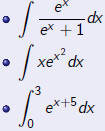The Natural Exponential Function
Outline
1 The definition of the exponential function
2 exp is an exponential function
3 The derivative of ex
Definition
ln, the natural logarithm, is an increasing function with domain (0,∞)
and
range R. Let exp denote the inverse of ln; thus, exp has domain R and
range (0,∞).
Elementary properties of exp
• The graph of exp can be obtained directly from the graph of ln.
• We have the important inverse relationships:
ln(exp(x)) = x and exp(ln(x)) = x:
Euler's number, e
Recall the definition of e : exp is the number such that ln(e) = 1:
(e≈2.71828)
Theorem
exp(r ) = er for all rational numbers r :
Definition
• Because exp(r ) = er for all rational numbers, we will define ex by
exp(x) for all real numbers x:
• In particular,
ln ex = x and eln(x) = x.
Theorem (The laws of exponents)
• ex+y = ex ey
• ex-y = ex/ey (for homework)
• (ex)r = erx (for homework)
Problem
Solve the following equations:
• e2x-3 = 8
• e2x + 2ex - 8 = 0
Theorem

Problem
Find y' in each case:

Problem
Solve the following integrals:

Problem
Sketch the graph of y = xe-x.


